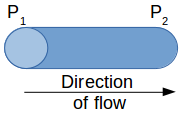Tags | |
The Darcy's Law (Physiology) calculator computes the blood flow (F) through a vessel based on a change in pressure (ΔP) and a resistance factor (R).
INSTRUCTIONS; Choose units and enter the following:
- (ΔP) Change in pressure between points (P1 and P2)
- (R) Resistance Factor.
Flow Rate (FR): The calculator returns the Flow Rate in milliliters per minute. However this can be automatically converted into other volumetric flow units via the pull-down menu.
Heart / Blood Calculators:
- Compute the Heart Chamber Pressure via the Law of Laplace
- Compute the Heart Wall Stress via the Law of Laplace
- Compute the Blood Flow Rate using Darcy's Law
- Compute the Change in Vascular Pressure
- Compute Blood Pressure
- Compute the Blood Volume in a Human based on their weight
- Change in vascular pressure (ΔP) , (ΔP=P1-P2), CLICK HERE.
- Mean Arterial Pressure (MAP): Calculates MAP from Pulse Pressure and Diastolic Pressure
- Mean Arterial Pressure and Pulse Pressure: Calculates MAP and Pulse Pressure from Diastolic Pressure and Systolic Blood Pressure
- Cardiac Output from Heart Rate and Stroke Volume
The Math / Science
Darcy’s Law was created to describe the flow of a fluid through a porous medium, specifically the flow of water through sand. The law has been significantly simplified for this application to Physiology here. See Darcy's Law (Engineering) for the more explicit version of this equation as typically applied to hydrogeology and engineering applications.
In the physiology application, Darcy’s Law has been interpreted as defining blood flow against resistance, where the peripheral resistance of the circulatory system to blood flow is analogous to the resistance of a medium like sand to the flow of water. The two inputs to this equation are:
- Mean Arterial Pressure in units of mmHg - millimeters of mercury
- Total Peripheral Resistance in units of mmHg * (min/L)
Darcy's Law returns the cardiac output in terms of Liters per minute.
The Math
The Darcy's Law formula was derived from experimental data by Henry Darcy has the following form:
Q=-k⋅A(Pb-Pa)μ⋅L, where
- k = the intrinsic permeability of the medium
- A = the cross-sectional area through which the fluid will flow
- Pb-Pa = the total pressure drop
- μ = viscosity of the fluid
- L = the length over which the pressure drop occurs
As you can see in contrast, the physiology version of "Darcy's Law" is somewhat simplified:
Cardiac Output = (Mean Arterial Pressure) / (Total Peripheral Resistance)
References
- Ali Nasimi (2012). Hemodynamics, The Cardiovascular System - Physiology, Diagnostics and Clinical Implications, Dr. David Gaze (Ed.), ISBN: 978-953-51-0534-3, InTech, Available from: http://www.intechopen.com/books/the-cardiovascular-system-physiology-diagnostics-and-clinicalimplications/hemodynamics

